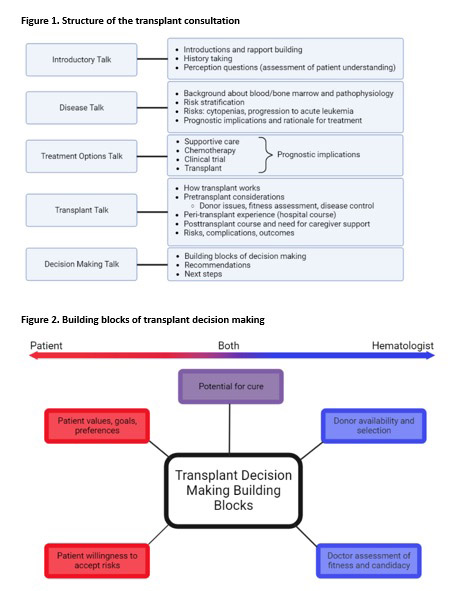Introduction: Allogeneic hematopoietic cell transplantation (alloHCT) offers a chance of cure for many patients with blood cancers including higher risk myelodysplastic syndromes (MDS) but carries many risks. In this high risk, high reward situation, shared decision making is essential to empower patients to make goal-concordant decisions. We detail communication strategies hematologists use to discuss treatment options including alloHCT and to facilitate shared decision making with patients.
Methods: Our research team recruited hematologists who routinely perform alloHCT in the United States through email. Participants conducted a video-recorded virtual encounter lasting up to one hour with an actor portraying a 67-year-old man with recently diagnosed high risk MDS referred for specialty hematology consultation to discuss treatment options including alloHCT. We transcribed and qualitatively analyzed hematologists' communication approaches.
Results: Participants (n=37) from 25 institutions were a median age of 44 years (range 33-73 years) and mostly male (65%) and white (65%). More than half spent >50% of their clinical time in managing alloHCT patients. Hematologists followed a similar conversation structure, though varied in the amount of detail they provided within each of the main sections (Figure 1). Their conversation routinely included an assessment of the patient's perception of his condition, information about MDS, and discussion of treatment options including transplant and chemotherapy and less commonly supportive care or a clinical trial. Many repeatedly highlighted that transplant was the only option with the potential for cure. Their discussion about transplant frequently followed a chronological approach from pretransplant considerations including donor issues, formal fitness testing, and disease control; to the peri-transplant period and hospital experience; and through the posttransplant course including need for dedicated caregiver support. Hematologists discussed risks, complications, and major outcomes at varying lengths.
Decision making talk occurred at different points in the visit though was often concentrated in the latter part of the conversation. Hematologists referred to several elements that formed the basis of treatment decision making (Figure 2). While hematologists indicated that multiple factors should inform the patient's and hematologist's decision making, many honed in on transplant's position as the only chance for long-term survival. Although most hematologists acknowledged on a general level the importance of patients' goals and preferences in decision making, they elicited and incorporated the individual patient's specific goals into the discussion to varying degrees. Instead, in several conversations, hematologists' assessment of the patient's fitness and candidacy for transplant was prominent in their discussion about whether the patient could and should consider pursuing the curative option.
Hematologists frequently recommended that the patient take time to think and talk with his family about the treatment decision in the immediate future. The strength of their longer-term recommendations ranged from strong recommendations for transplant or chemotherapy to conditional recommendations for transplant or deferral pending further information. These recommendations reflected a range of decision-making strategies, from a physician-led approach to a primarily patient-guided effort. In the middle, some hematologists described a collaborative effort with the patient, in which the patient and hematologist would work together to reach a shared decision. Within a single encounter, many hematologists expressed various statements suggesting that their approach to decision making did not fit tightly within a single domain but rather fell along a continuum which evolved as the encounter proceeded.
Conclusions: The transplant decision making discussion is complex. The ways in which hematologists frame information and engage patients affect how they make decisions together. Hematologists consistently discuss similar major content areas as they navigate from beginning to end; identification of these key components can be used as the basis for creation of a communication tool to help hematologists discuss alloHCT with patients.
Disclosures
No relevant conflicts of interest to declare.


This feature is available to Subscribers Only
Sign In or Create an Account Close Modal